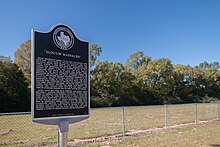Slocum massacre
In the post-Reconstruction era, conservative white Democrats regained control of county and state governments, and passed laws at the turn of the century to disenfranchise African Americans.
The combination of unfruitful land and small farms made blacks more susceptible to falling into debt when they didn't have a good harvest season.
First, there was an argument over a promissory note between Marsh Holley, a black businessman, and Reddin Alford, a disabled white farmer.
District Judge Benjamin Howard Gardner realized that the combination of alcohol, guns, and rumors about black uprisings could create a dangerous and potentially deadly outcome.
[2][5][6] Sheriff William H. Black said that "Men were going about killing Negroes as fast as they could find them, and, so far as I was able to ascertain, without any real cause".
Because of the fear in both the white and black population, governor Thomas Mitchell Campbell ordered Texas Rangers and the State Militia to Anderson County.
[2] Even with the rumor of a black uprising against whites proven false, Marsh Holley, a witness to murders and one of the reasons that the Slocum massacre began in the first place, was put in jail as protection.
[7] Besides the Holleys, seven other men who died in the massacre were Cleveland "Cleve" Larkin, Sam Baker, Dick and Jeff Wilson, Ben Dancer, John Hays, and Will Burly.
However, The Palestine Daily Herald told some parts of the truth about how white people thought that African Americans were plotting against them.
[2][11] Twenty years after the massacre, a man named Hayes owned land in Slocum that the town needed.
[2] Despite efforts by African Americans to draw attention to the massacre, the federal government remained largely uninterested in investigating the murders or bringing criminal prosecutions.
John A. Siddon, a Volga postmaster, sent a letter to Cecil A. Lyons, chairman of the Texas Republican State Executive Committee in Sherman, asking for his help in securing a federal investigation.
Taft sent this letter to Wickersham, and he responded to the ministers by saying that the federal government could not fulfill their requests or become involved because no constitutional rights were being violated in any of these instances.
Anderson County District Court Judge Benjamin H. Gardner released a statement that said that law enforcement would start turning away and shooting to kill (if necessary) those who sympathized with the mobs or participated in them.
Gardner called a grand jury to identify suspects in the case and intended to prosecute men indicted as a result.
Anderson County Deputy Sheriff Riley Reeves arrested Jim Spurger, who was involved in one of the initial conflicts.
[2] Judge Gardner knew that whites would have the majority even if a crime was committed, so he asked the jurors to excuse themselves if it was impossible to complete a fair trial.
[2][8][13] Historian E. R. Bills has collected oral histories of the massacre, among them accounts from Mable Willis and Annie Mae Killgo.
She remembers her parents helping African Americans by opening their house as a place of refuge for those running from mobs.
Elvie Ewell, a black girl, said that her father, uncles, and cousins were outside at the beginning of the riot, and were warned that white men were forming mobs and killing any African Americans that they could.
Lastly, the Sadlers recalled the Barnett family, who were African American, coming to their farm to seek help.
[2] Annie Mae Killgo, a young white woman, said that in the weeks leading up to the massacre, there were local rumors that a Black uprising would take place.
A group of white men found a Black girl near a creek and dunked her head until she admitted that an uprising was being planned.
She said that, in an attempt to provoke the attack before it began, white men placed women and children in churches and schools.
[2] In August 2014, Constance Hollie-Jawaid, a Dallas Independent School District administrator whose great-grandfather, Jack Holley, was among victims of the Slocum massacre, enlisted historian Bills to help apply for a Texas state historical marker commemorating the massacre.
Members of the Anderson County Historical Commission opposed the application, claiming a lack of evidence and stating that there had not been a race riot.
[15] On January 16, 2016, a historical marker telling the story of the massacre was dedicated; it is located one-half mile (0.80 km) south of Slocum, on FM 2022.
The massacre and its backstory are also the subjects of unpublished essays: "Bad Saturday: Revisiting the 1910 Slocum Massacre", by Norris White Jr., a Stephen F. Austin State University student; and "Racial Disorder in East Texas: The 1910 Slocum Incident" by Linda Sue Stuard, a University of Texas at Tyler student.


